
“Clarence H. White Autograph”: Black ink, 1916. By his own hand, White autographed a manilla card-stock mount (36.2 x 28.6 cm) featuring a portrait photograph of himself taken by student Ruth Anthony Davis during the Seventh Summer Session of the School of Photography at Stevens Farm in East Canaan, CT that year. Please see portrait below. From: PhotoSeed Archive
When I remarried a dozen years ago, an obscure bit of farce entered the equation leading up to the “I do” moment. The fateful convolution? My beloved hailed from Newark, OH: the same Midwestern US city where pioneering art photographer Clarence Hudson White (1871-1925) had spent his formative years before leaving permanently along with his family to New York City in 1906.
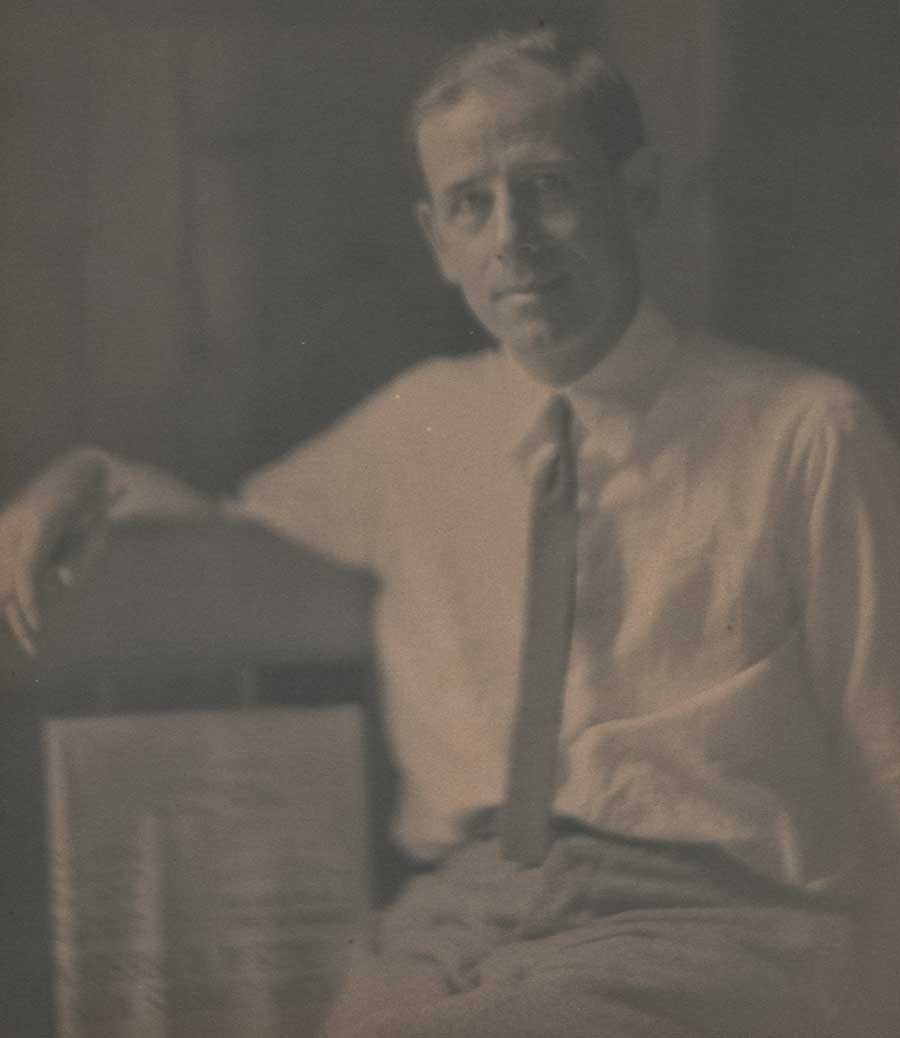
Detail: “Portrait of Clarence H. White”: Ruth Anthony Davis, American (1880-1979): 1916: vintage platinum print: 24.2 x 19.3 cm | 29.0 x 21.5 cm Japan paper | 36.2 x 28.6 cm manilla card-stock: Davis, an early member of the Providence Camera Club, photographed her instructor Clarence Hudson White while she attended the Seventh Summer Session of the School of Photography at Stevens Farm in East Canaan, CT. A description of the school’s location with emphasis on potential photographic subjects for students appeared in the March, 1916 issue of the International Studio: “The seventh summer session of the Clarence H. White School of Photography will be held at East Canaan, Connecticut, instead of Sequinland, Maine, as heretofore, during July and August. East Canaan is situated in a beautiful valley in the Berkshire Hills of Northern Connecticut, at an elevation of eight hundred feet above the sea level, and is surrounded by hills rising another eight hundred feet above the floor of the valley. The country furnishes abundance of photographic material, comprising, within easy walking distance, farms, rolling uplands, streams, rugged mountains and architecture of typically New England character, many of the buildings dating from Colonial times. Numerous industries, such as iron furnaces, lime kilns, and the like, afford abundant opportunity for pictorial work. The neighbourhood is by no means thickly settled, and those persons who enjoy the seclusion of country life will find it here. Not least among the attractions of this portion of Connecticut are the delightful climate and the practical freedom from mosquitoes.” From: PhotoSeed Archive
But this aside is merely an excuse for the real purpose of this post: today is the official public opening of an exciting and ground breaking new exhibit on Clarence White at the Princeton University Art Museum in Princeton, New Jersey. Clarence H. White and His World: The Art and Craft of Photography, 1895-1925 will be on display there from October 7, 2017 to January 7, 2018. But don’t despair if you can’t make it right away, because the show travels to an additional three US museums through early 2019. Venue details along with additional links including one for the first comprehensive monograph on White published in conjunction with the show and authored by Anne McCauley, David Hunter McAlpin Professor of the History of Photography and Modern Art at Princeton University, concludes this post.

Detail: “Clarence H. White and His World: The Art and Craft of Photography, 1895-1925”: composite gatefold brochure for exhibit at Princeton University Art Museum which runs from October 7, 2017-January 7, 2018. Photographic illustrations by White left and middle: The Sea (Rose Pastor Stokes, Caritas Island, Connecticut) (detail), 1909, printed after 1917. Palladium print. Princeton University Art Museum, Clarence H. White Collection; middle: In the Orchard, Newark, Ohio (detail), 1902, printed after 1917. Palladium print. The Museum of Modern Art. Gift of Jane Felix White, 1941. Courtesy: Princeton University Art Museum
Several years before, I had taken a deep-dive into the remarkable life of White, whose arc resonated with me on many levels, especially his love for breaking the rules as applied to photographic lighting. To wit: what do you mean I can’t photograph my subject backlit? A simple optical concept today perhaps but in the late 1890’s? Revolutionary. I kid you not.
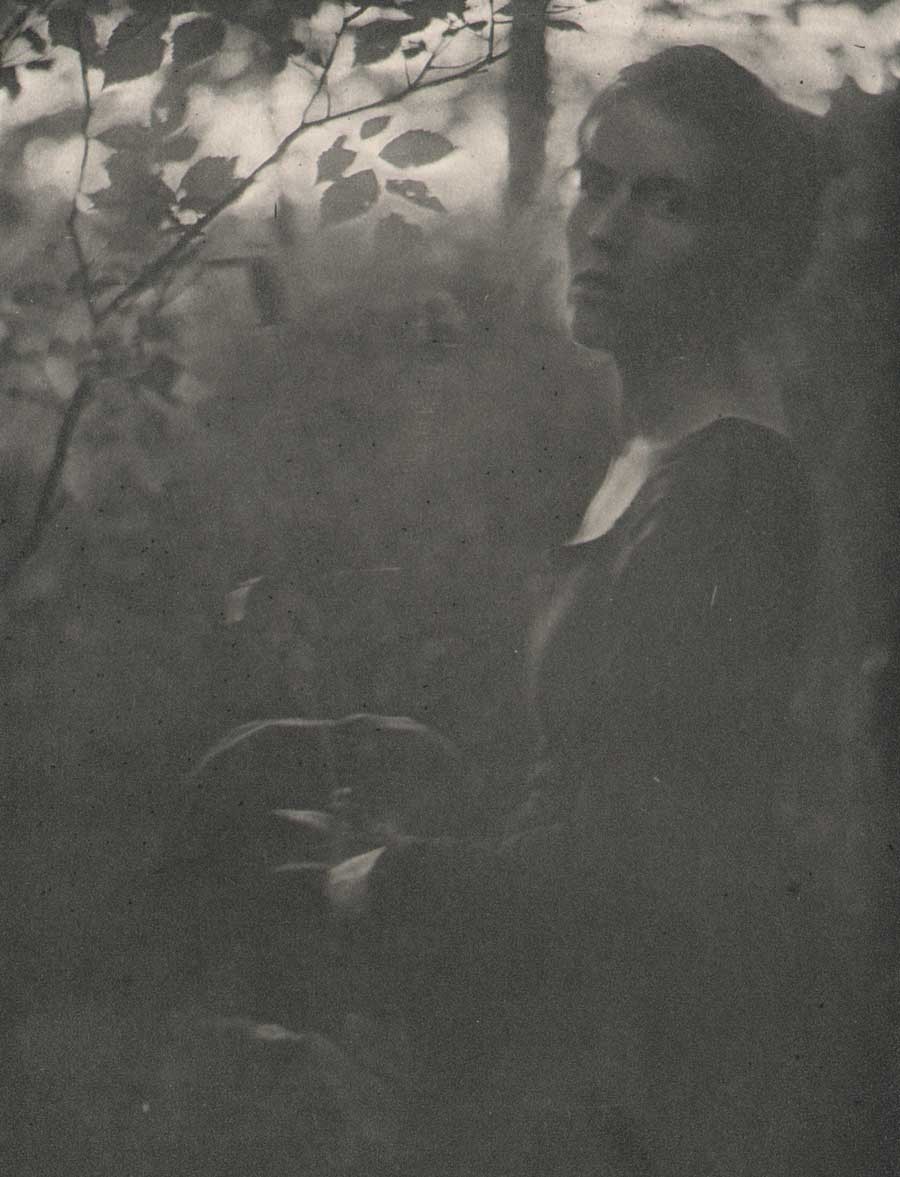
Detail: “At the Edge of the Woods Evening”: Clarence H. White, American (1871-1925): Chine-collé photogravure from Camera Notes, Vol. IV, April 1901: 14.4 x 10.1 cm | 28.6 x 19.6 cm uncut: The photographer’s sister-in-law, Letitia Felix is shown at twilight in a wooded setting. Alternately titled as In the Woods; Evening, the photograph was first exhibited in the Third Philadelphia Photographic Salon the same year. (cat.# 202) Later that year, it was exhibited as part of the Newark Camera Club’s exhibition in the town’s Association Building from November 28-December 1, 1900 where it was titled as Edge of the Woods Evening. The catalogue issued for the exhibit reproduced the photo as the frontis gravure for the publication. From: PhotoSeed Archi
In groundbreaking photographs by White such as his brooding landscape figure study At the Edge of the Woods Evening (1900), a remarkable twilight composition showing his sister-in-law Letitia Felix emerging from a thicket with just a hint of light on the horizon became just one example of his early output. White’s decidedly masterful reinterpretation of the possibilities of light and the photographic medium done with artistic intent was quickly getting accolades in the press, and his work was soon honored in salons the world over beginning at the end of the 19th century.
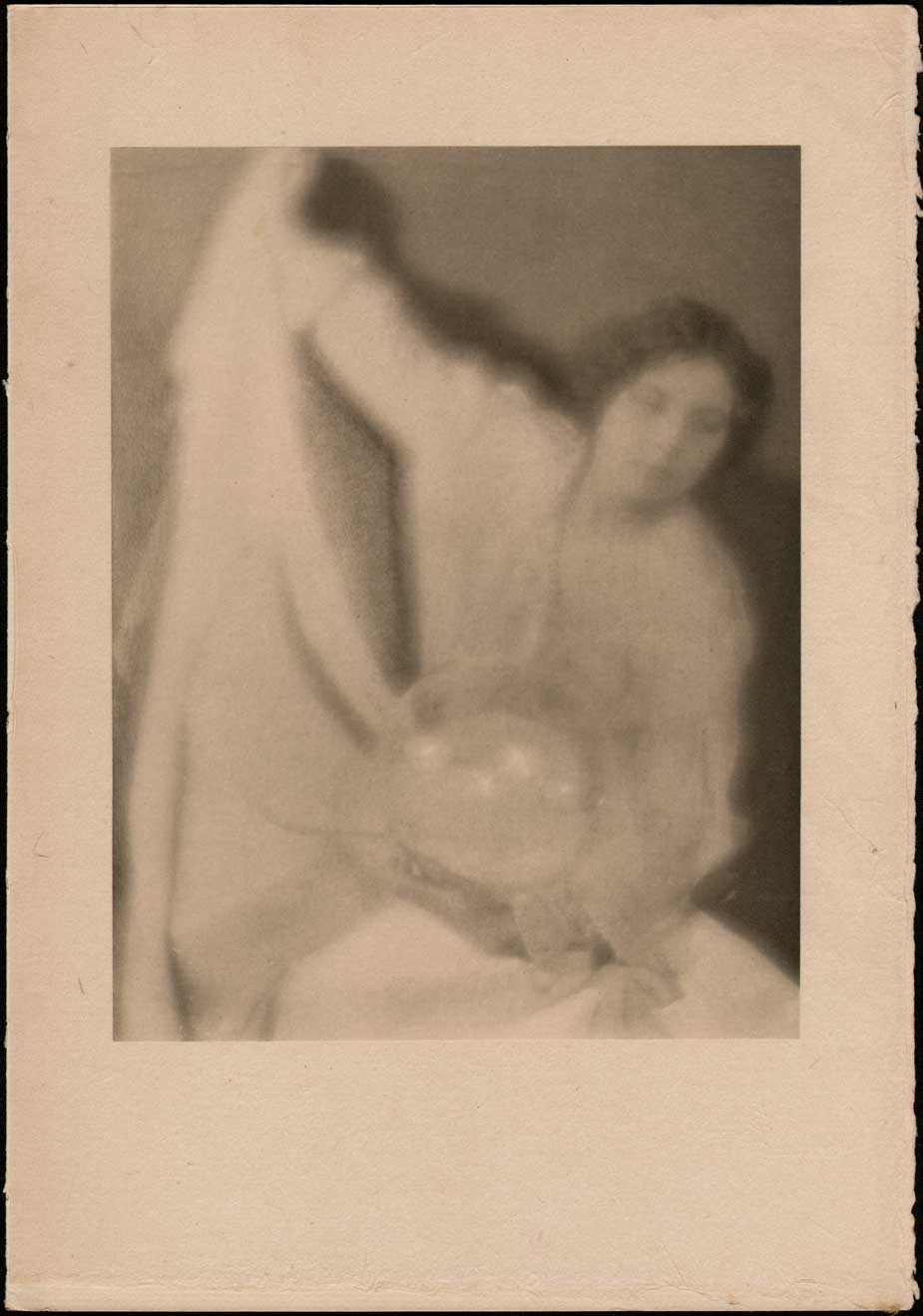
“Experiment 28”: Alfred Stieglitz 1864-1946 & Clarence White 1871-1925, Americans: vintage japanese tissue photogravure published in Camera Work XXVII: 1909: 20.6 x 15.9 | 30.2 x 21.1 cm: In 1907, the year after Clarence White arrived in New York City, he collaborated with Photo-Secession founder Alfred Stieglitz on a series of portraits featuring two models. Shown here holding a glass globe, California model Mabel Cramer poses in a portrait later reproduced as a plate in Camera Work. Said to be a friend of the German American photographer Arnold Genthe and possessing a face worthy of Cleopatra, Cramer and a woman known only as a Miss Thompson, posed for a series of photographs intended to promote photography as an equivalent medium to painting. It was the only time Stieglitz would ever work in tandem with another photographer and shows the extent to which the photographers were allied aesthetically and technically. From: PhotoSeed Archive
Not bad for a man with limited means and a high school education. Employed as a bookkeeper in 1890’s Newark nearly seven days a week for the same wholesale grocery firm his father worked at, (the family had moved there in 1887 from nearby West Carlisle, OH), White first took up amateur photography a year after his 1893 marriage to Jane Felix, with the young photographer diligently saving weekly spare change from his salary for camera and darkroom supplies. Reportedly, his reality of only being able to afford the exposure of several glass plates a week necessitated lots of planning in order to make successful photographs. With outdoor locations previously scouted throughout Licking County and interiors often taken in the darkened homes of family and friends, these same subjects were further cajoled into wearing fashions from the American Civil-War era or earlier in order to evoke feelings of times gone by for the compositions.
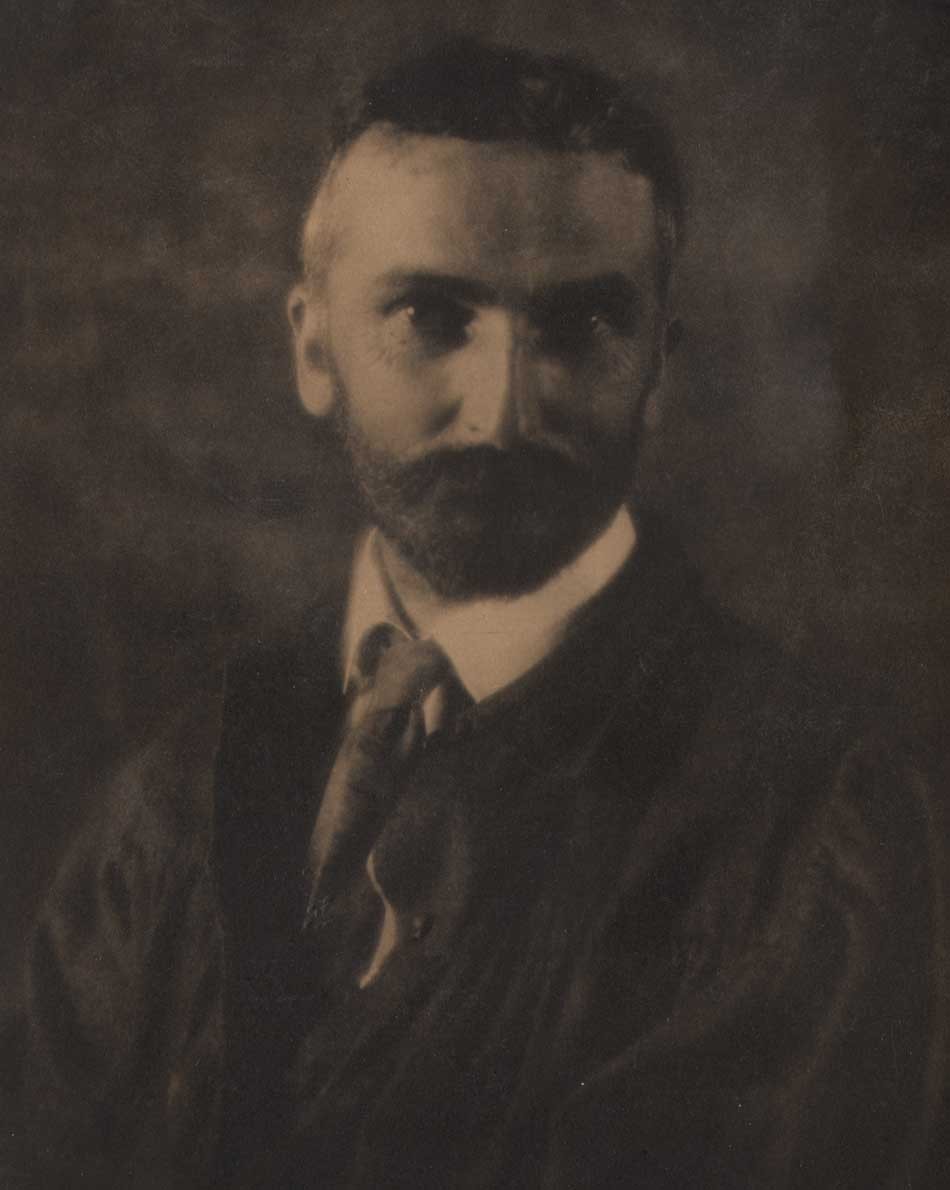
Detail: “Portrait of Arthur Wesley Dow”: Clarence H. White, American (1871-1925): vintage waxed platinum print, unmounted: 22.1 x 16.6 cm. From the Princeton University Museum website: “White was hired by Arthur Wesley Dow at Teachers College in 1907 and shared Dow’s philosophy that students of the fine and the applied arts should have the same fundamental training based on design principles (anticipating the approach of the Bauhaus in the 1920s).” from: PhotoSeed Archive
A founding member of the American Photo-Secession movement begun in 1902 by Alfred Stieglitz, White’s transition from Newark to New York City in 1906 began a new chapter of teaching by the photographer, who soon made the acquaintance of artist and arts educator Arthur Wesley Dow, (1857-1922) who hired White as an instructor at Columbia University’s Teachers College in 1907. White would go on to found his own groundbreaking schools of artistic photography utilizing a modern pedagogy learned from Dow among others: first in Maine beginning in 1910 and then in New York City in 1914. Besides emphasizing pictorial photographic technique as well as numerous technical processes as part of the school curriculum, modern composition as espoused by Dow was taught along with art history through lecture format in classes by artists including early American cubist painter Max Weber (1881-1961) and later by artists including Charles James Martin (1886-1955) in the early 1920’s.
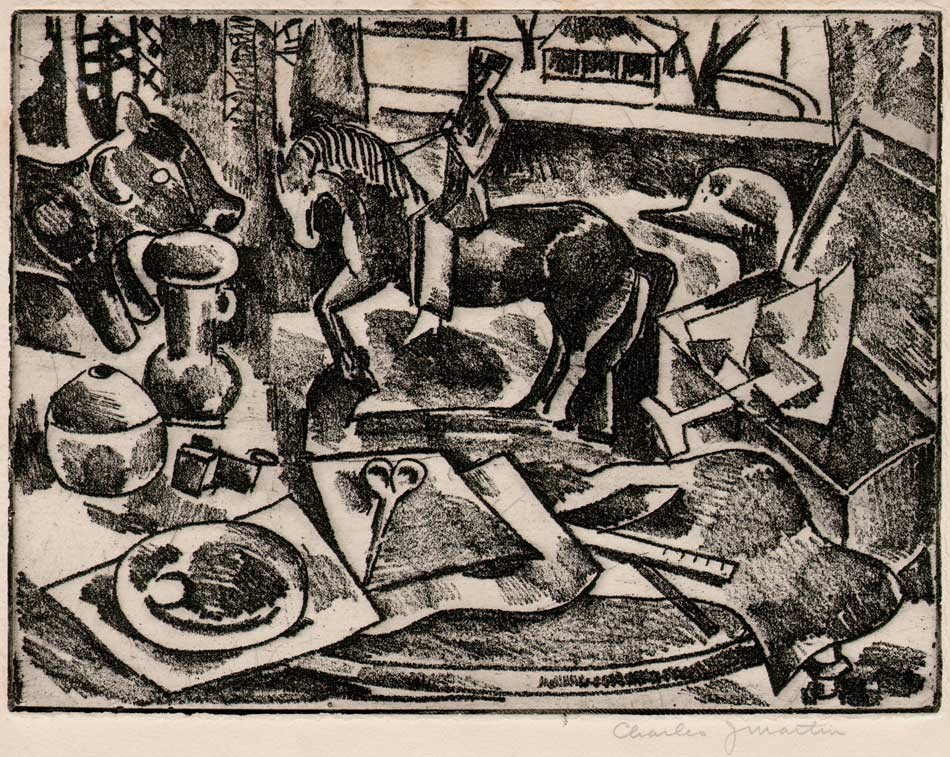
“Interior Composition with Figurines”: Charles James Martin, American (1886-1955): vintage etching on plate paper ca. 1915-20: 15.1 x 20.1 | 18.8 x 24.8 cm (trimmed): Martin studied with Arthur Wesley Dow, and later taught alongside him at Columbia University Teachers College. At TC, he also studied photography with Clarence H. White, and became an instructor at White’s School of Photography in 1918. Martin began teaching at the Art Students League of New York in 1921. The following background on Martin and his involvement with the White school appeared in the February, 1921 issue of “The Touchstone and the American Art Student Magazine”: “The Clarence H. White School of Photography announces a course of instruction in Print Making by Prof. Charles J. Martin of the Department of Fine Arts, Columbia University. The purpose of the course is to develop an appreciation of prints through a study of fine examples and particularly through practice in etching plates, cutting blocks and printing. There will be also an opportunity to do photo-engraving such as the line cut and photogravure. The course will consist of twenty sessions. The earlier sessions are now under way, and the response to this announcement gives evidence that the student of the Photographic Arts is endeavoring to gain practical knowledge as well as artistic reproduction.” p. 406: from: PhotoSeed Archive
At 54, Clarence White died of a heart attack while accompanying photo students during a summer session of his school in Mexico City in 1925. Besides his important contributions as a ground-breaking photographic artist in the late 19th and early 20th century, his legacy as a teacher is perhaps more important as we finally begin to reevaluate his importance in the larger history of early artistic photography. The Princeton exhibition and accompanying monograph-the first truly comprehensive volume on White ever published, will further our understanding and appreciation for this gentleman.
PhotoSeed is honored to have played a small role in the exhibition showcasing Clarence White’s talents at photographic book illustration. A slim volume loaned for the show, Songs of All Seasons, published in 1904 with prose by his uncle Ira Billman and photographs by White, will be included in an exhibit display case. An additional rare illustrated copy of Irving Bacheller’s best-selling novel Eben Holden from 1903, with photogravure plates by White, will also appear after it was acquired by Princeton from this archive. This site further intends to publish additional posts over the next several years chronicling White’s groundbreaking schools of photography as well as other aspects of his early and later life in Newark, OH and New York.
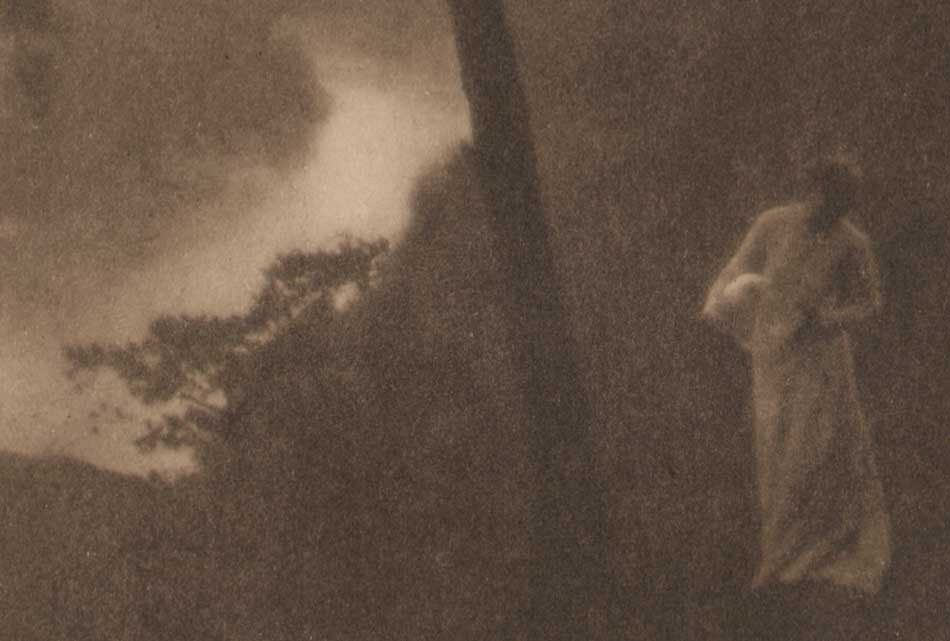
Detail: “Morning”: Clarence H. White, American (1871-1925): 1905: vintage photogravure published in the volume “The Artistic Side of Photography” by A.J. Anderson: London, Stanley Paul & Co., 1910. 11.9 x 9.3 | 22.5 x 15.1 cm. The plate, titled “A Landscape”, from a platinotype in the collection of A.L. Coburn, appears on p. 155. This moody landscape photograph with figure was taken by White on the bluffs in Newark, Ohio overlooking the Licking River, a location that appears in several of the photographer’s compositions. From the Metropolitan Museum of Art Website, which holds an original platinum print dated to 1905 bequeathed by Alfred Stieglitz: “Morning perfectly embodies the tenets of Pictorialism: expressive, rather than narrative or documentary, content; craftsmanship in the execution of the print; and a carefully constructed composition allied to Impressionist and American Tonalist painting and to popular Japanese prints. His photographs from the period before he moved to New York in 1906 signaled a remove from the modern urban world. Neither genre scene nor narrative tableau, this photograph is a retreat into domesticized nature.” From: PhotoSeed Archive
EXHIBITION SCHEDULE: Clarence H. White and His World: The Art and Craft of Photography, 1895-1925
Princeton University Art Museum (10/07/17–01/07/18)
Further link to the exhibit at Princeton
Video: Breaking down photographic processes used by Pictorialist photographers: a collaboration between the Princeton University Art Museum and the Yale Institute for the Preservation of Cultural Heritage.
Davis Museum, Wellesley College (02/13/18–06/10/18)
Portland Museum of Art, Maine (06/22/18–09/16/18)
Cleveland Museum of Art (10/21/18–01/21/19)
Book link:
October 31, 2017 408 pages, 10 x 11 1/2346 color + b/w illus. ISBN: 9780300229080 Hardcover
Distributed for the Princeton University Art Museum



